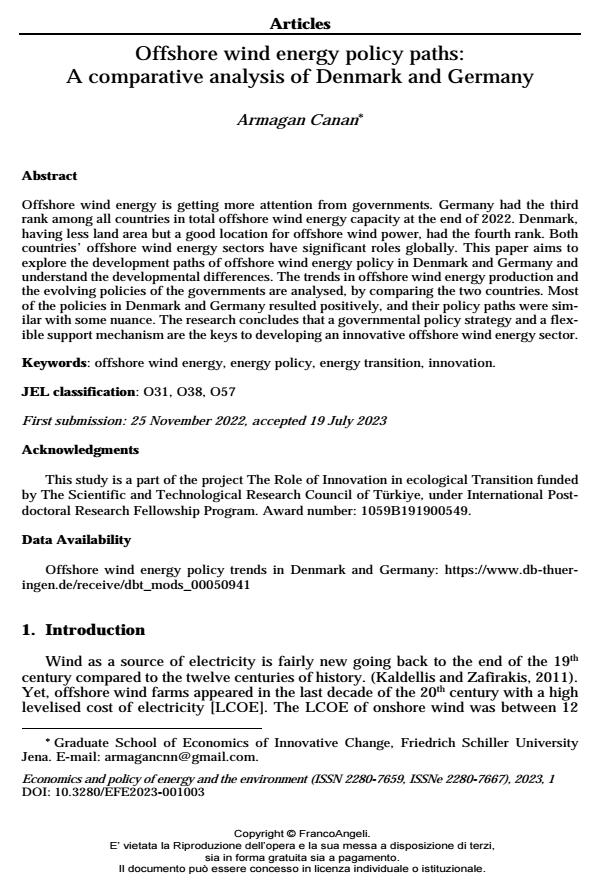Offshore wind energy policy paths: A comparative analysis of Denmark and Germany
Journal title ECONOMICS AND POLICY OF ENERGY AND THE ENVIRONMENT
Author/s Armagan Canan
Publishing Year 2023 Issue 2023/1
Language English Pages 25 P. 35-59 File size 182 KB
DOI 10.3280/EFE2023-001003
DOI is like a bar code for intellectual property: to have more infomation
click here
Below, you can see the article first page
If you want to buy this article in PDF format, you can do it, following the instructions to buy download credits

FrancoAngeli is member of Publishers International Linking Association, Inc (PILA), a not-for-profit association which run the CrossRef service enabling links to and from online scholarly content.
Offshore wind energy is getting more attention from governments. Germany had the third rank among all countries in total offshore wind energy capacity at the end of 2022. Denmark, having less land area but a good location for offshore wind power, had the fourth rank. Both countries’ offshore wind energy sectors have significant roles globally. This paper aims to explore the development paths of offshore wind energy policy in Denmark and Germany and understand the developmental differences. The trends in offshore wind energy production and the evolving policies of the governments are analysed, by comparing the two countries. Most of the policies in Denmark and Germany resulted positively, and their policy paths were sim- ilar with some nuance. The research concludes that a governmental policy strategy and a flex- ible support mechanism are the keys to developing an innovative offshore wind energy sector.
Keywords: offshore wind energy, energy policy, energy transition, innovation.
Jel codes: O31, O38, O57
- Marine Spatial Planning for Offshore Wind Firms: A Comparison of Global Existing Policies and Data for Energy System Storage Yun-Sin Chen, Cheng-Yu Hu, Chun-Yi Li, Jia-Bin Lin, Yi-Che Shih, in Sustainability /2025 pp.5884
DOI: 10.3390/su17135884 - Offshore wind farms: An overview of licensing and legislation of North European countries Athina Danai Vardaka, Jacob G. Fantidis, in Wind Engineering 0309524X251406380/2025
DOI: 10.1177/0309524X251406380
Armagan Canan, Offshore wind energy policy paths: A comparative analysis of Denmark and Germany in "ECONOMICS AND POLICY OF ENERGY AND THE ENVIRONMENT" 1/2023, pp 35-59, DOI: 10.3280/EFE2023-001003